September/October 2015
The Fat Lady Sings at Last
One last swing through Holland and Britain before we ship La Tortuga Home from Europe
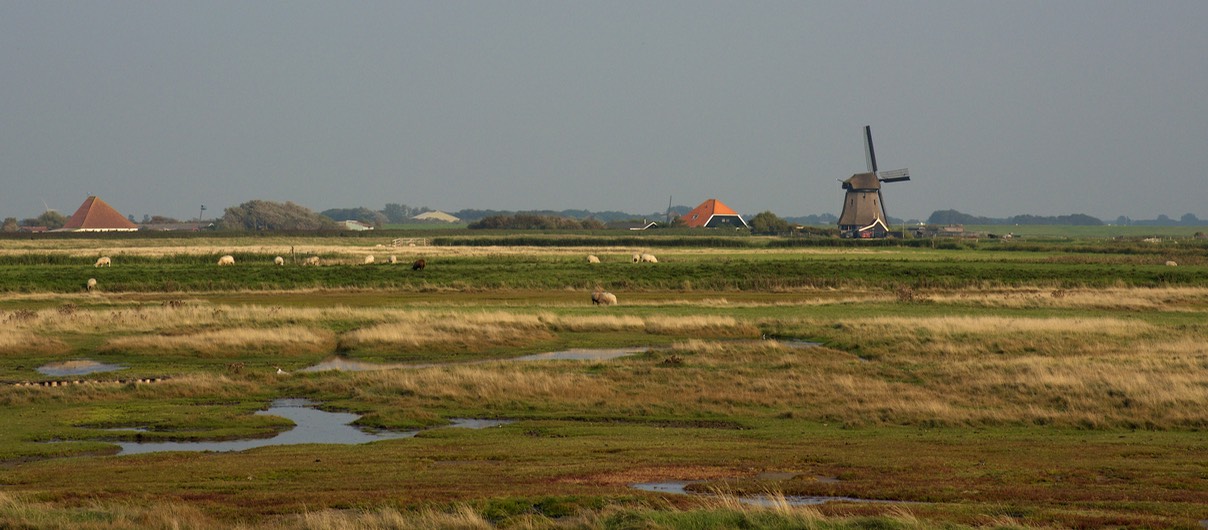
There’s an expression in American sportscasting that “It ain’t over ’til the fat lady sings.” Well, after six seasons of European travel in our Tiger motorhome we are calling it quits. As we write this, the Tiger is aboard ship and traveling from Southampton, England to Jacksonville, Florida, and for us, the fat lady has indeed done her thing as we close one chapter in our book of travel.
It was shortly after leaving Iceland and arriving back on the European continent that we finalized a momentous decision we’d been pondering — at the end of our 2015 season we would indeed ship the Tiger back to the U.S. and we would do this from England. So we temporarily shelved our plans to further explore eastern Europe and decided to turn west rather than east. This meant that we had until late August to enjoy the Continent, and then we would have to leave mainland Europe and head for Britain. It was an interesting time in Europe, with all the sad, hopeful immigrants clogging the borders and trying so hard to get on board the channel ferries or the Chunnel in order to get to Britain. We felt so very fortunate that our passports were secure and that we weren’t fleeing terror.
In researching possibilities for shipping, we found that our options for shipping dates was more limited than we had hoped and we ended up with a date in mid-October, somewhat earlier than we would have liked. This gave us a few weeks less time in Britain than we would have preferred but there you are. The end result of all this is that we are already back in the States and the Tiger has sailed out of Southampton to meet us in Florida mid-November.
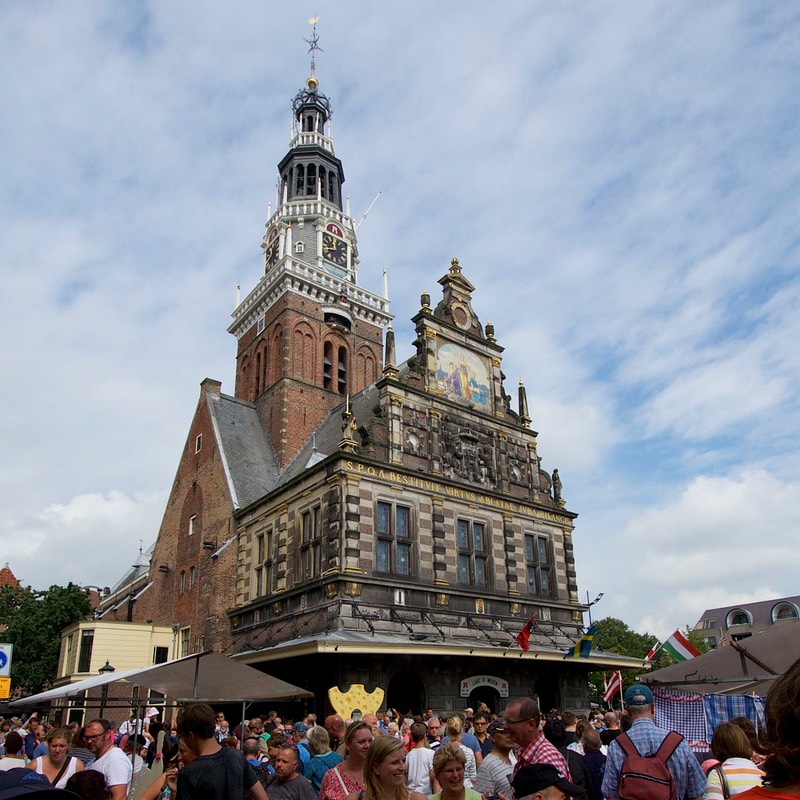
But in the meantime! We quickly decided that the time between disembarking from the Icelandic ferry (August 4) until we flew home should be spent doing splendid and wonderful things: we would visit with friends in Germany and Holland and Britain, and seek out parts of those countries we’d either never visited or couldn’t stand the idea of leaving without just one last chance to enjoy them. And that’s what we’ve been doing, in spades.
We spent a great week in Hamburg with Toni and Berit. I washed absolutely every single thing in the Tiger; Berit’s wonderful and efficient machine (German ingenuity at its best) is still staggering from the attack on its sensibilities. She and I went for long walks in the nearby woods; to fresh produce markets where, among other delicacies, we bought honey to die for; to the farm market to buy jams of many flavors, each with a bit of rhubarb to spice it up (quite superb!); and then she made appointments for us to have real haircuts by a real professional! who happened to be her brother. Oh yeah, and we got two new tires and a new motor for the macerator pump. Such a splurge.
Hamburg is a fine city with lots of attractions, but after a week or so of all this we wanted to move on toward The Netherlands. Keeping an eye on our rapidly expiring Schengen visas, we booked a reservation for later in the month; we would be taking a ferry from the Hook of Holland (north of Rotterdam) to Harwich, along the coast of East Anglia. We had time to park up for a few days on the edge of a small town, Diepholz, where we made friends with some other campers, spent the 10 minutes necessary to explore the village, and started making arrangements to meet up with friends near the cheese market towns of Holland.
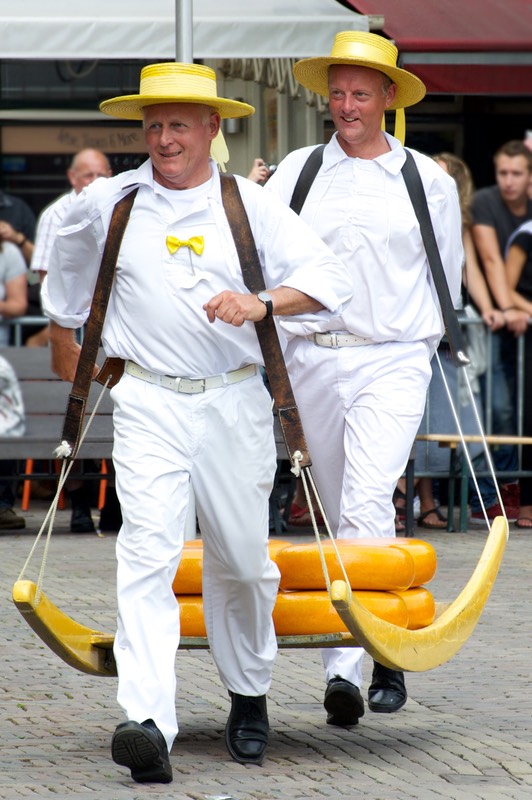
Aaaah, the cheeses. Gouda, Edam, and many others. Piles of cheeses everywhere, in stacks too high to see over. In their eponymous towns of origin, but also in Alkmaar, with its ancient open-air cheese market that attracts tourists by the zillions. Here you can see the cheese being moved around in the “old” way — by teams of men who put the large yellow wheels on sleds and briskly march them out to the auctioneer and then back into the old brick building where they are claimed and paid for. It was a fun experience and quite a sight, though this is August in Europe and the crowds took us somewhat aback after the quiet and solitude of Iceland.
Holland is charming; we’ve been here before and it was a pleasure to return. We were now reunited with George and Kate, our Aussie friends to whom we’d waved good-by when we left them behind in Iceland a few weeks earlier. We joined them near Schagen, just behind the enormous barrier that keeps the North Sea from flooding Amsterdam and surroundings. This barrier (dike, I guess) has just been extended further out to sea, and there are new beaches to walk on, biking trails, and other niceties. The locals were using the area extensively in the nice weather we were enjoying (yeah!!!) and it was fun to be there.
We parked up for a couple of days while Kate showed us around the area, which was where she’d grown up. We poked around in the countryside and enjoyed Schagen and Bergen, along with a lengthy visit to Alkmaar. In Bergen, Rick and I were treated to pannenkoeken at Duinvermaak’s, a tradition there since 1913 and a treat Kate had enjoyed as a child. Total decadence, with absolutely no socially-redeeming virtues. Wow!
August 24, our day of reckoning, was fast approaching. By midnight on that day we had to be outta Schengen. Thus we were catching the ferry to England in the afternoon. So we made our way south of Amsterdam, fought the spaghetti freeway system near Rotterdam, and made our way to the Hook of Holland. Along the way we bought some Dutch treats to carry away with us, including a heroic supply of licorice treats, which we adore (gee thanks, Casper, for introducing us to them — we think!).
Preparing to go onboard yet another ferry, I had an interesting thought. The very first time I was in Europe — 1964 would you believe — I was on a student tour comprised of about two dozen very excited college kids. It began in London, and then, leaving Britain, we took the boat train to the continent. Our arrival point was that very same Hook of Holland. There must be something significant in this, even if it eludes me.
Well, this ferry ride, in 2015, wasn’t nearly as much fun. Jammed with vacationers returning to Britain, it was noisy, full of yelling children and their very tired parents, and lasted 6 long hours. But we prevailed as usual.
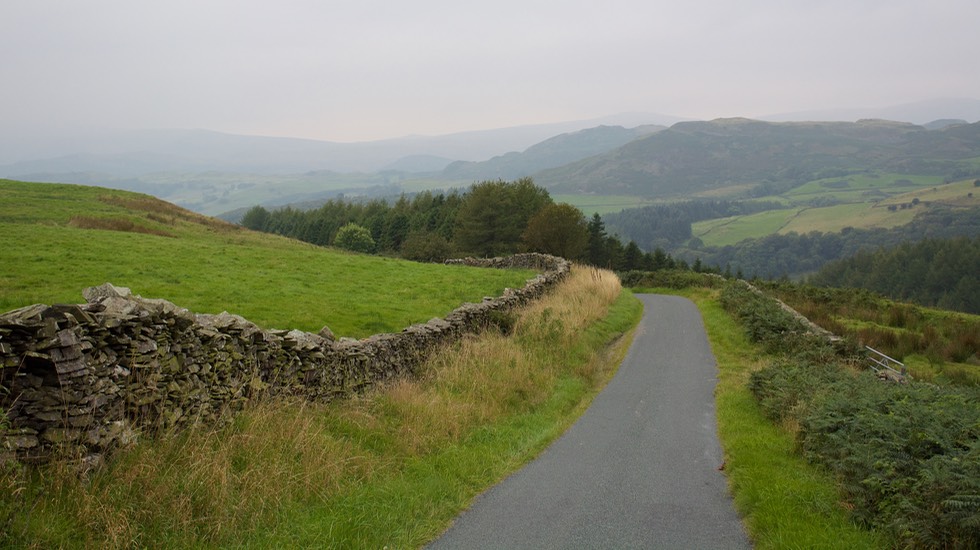
And… returned to Britain, a favorite of ours. So, what to do whilst we were here? We’d made a list of “What do we still want to do in Britain if we’re not sure we’ll ever be back”, an impossibly long list you can be sure. We added and subtracted and tried to make sense of it all, checked up on upcoming events we might enjoy and then dove right in. We knew our shipping date would close in on us far too soon, but we refused to be denied the pleasures of what we call “Treasured Moments” — small but great sights and experiences that we can squeeze into our treasure chest of European memories. There were lots of them on our list, but we figured we had most of a couple of months for this project; plenty of time, right? Ha!
It being late August, and therefore still les vacances all over Europe, we wanted nothing to do with England’s major cities (i.e., London and surrounds) or tourist attractions. Carefully skirting metropolitan areas, we worked our way up the east side of the country, through fens and such, and then headed for Oulton Park and the races. Four days of historic sports car racing seemed like just the ticket. And it was, like, totally brilliant as the locals say.
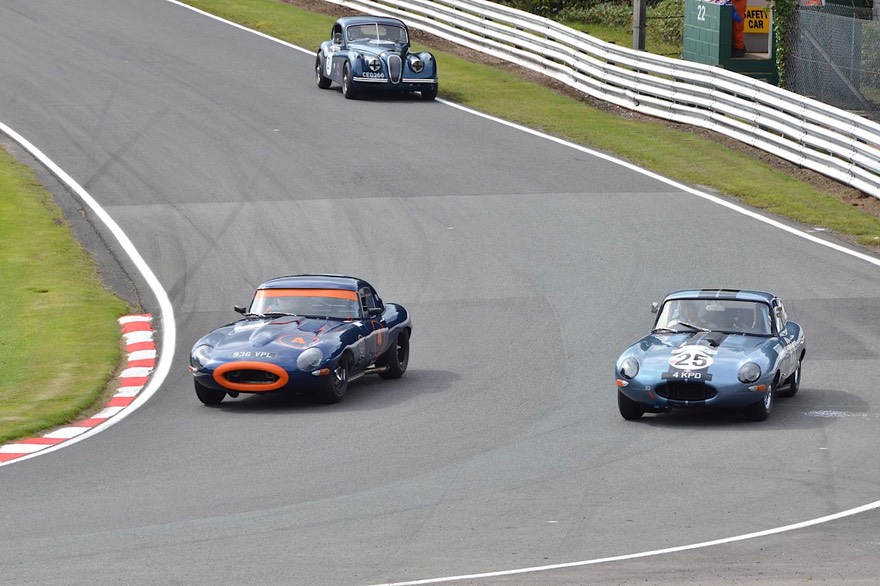
Oulton Park is in northern England, not far from Chester and south of Manchester, and has long been on Rick’s list of locales to visit. It’s quite old, set amongst huge trees in a lovely park, and the race track isn’t bad either. We had a good time. Rick was in seventh heaven, and as he says “I didn’t even have to die first, either.” He was up at dawn (well…..) and out checking on the qualifying times, visiting the pits, and establishing the best sight lines for the days’ events. Great fun. Got hooked up with some local Yorkshire lads who were camping next to us, and that was fun too. It was a super start to a visit to Britain.
Heading south from the races we stopped off at the RAF Museum in Gosford to take some pictures. We’d visited last year while running around with cousin Des, who lives nearby, but were somehow without our cameras at the time. We needed to correct the oversight so that we could add the museum to motor-museums.com. It is a neat museum focusing on the events and airplanes of the Cold War period; very well laid out and displayed.
Timing being everything when you’re traveling, we next had to head a long ways back down south, into the Cotswolds, where we met up with an interesting group in the Malvern Hills area. The Silk Route Club is an amalgamation of folks with varying backgrounds who share an interest in overland travel. They gather yearly, usually somewhere in England, to discuss plans for trips and share information on where they’ve been. Finding ourselves in England during the time when they would be meeting, we joined in, joined them, and made some new friends. A nice group of folks, and experienced travelers all.
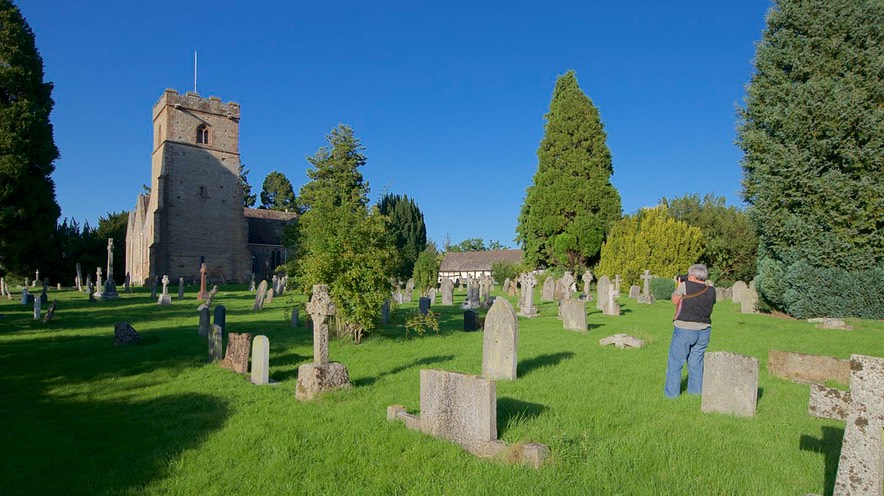
While in the Malvern Hills area, Rick found time to run past the Morgan Factory once again and drool over the cars for a bit while securing a new hat from the shop. We took advantage of the lovely countryside and spent a quiet night in the Shropshire Hills along the ridge of the Long Wynd. Lord what stunning views; this area is much like Scotland, with heather in bloom, rolling open ground, and plenty of sheep. Baaaa. The next morning we were sitting above the fog, and it was lovely. Moving on, we passed through Prees, Prees Green, Prees Lower Heath, Prees Higher Heath, and Prees Heath. Only in England….
We wanted to spend time in Scotland, and so we started north again. A few years ago we had driven through the Lake District and had been a bit unhappy about the sheer number of people around. On that trip we’d been traveling through the eastern, most popular/populated area. We wanted to see if the western side of the district was as crowded, and we were quite pleasantly surprised. We were met by piddling little roads with stone fences, very few folks, many more sheep than anywhere else, pretty countryside, and lovely rolling hills. We were quite delighted. We wandered this quieter portion of the Lake District in nice autumn weather, with Kathy happily taking far too many pictures to be sensible; Rick couldn’t see past the edges of the side mirrors as the walls and hedges and other traffic went whizzing by.
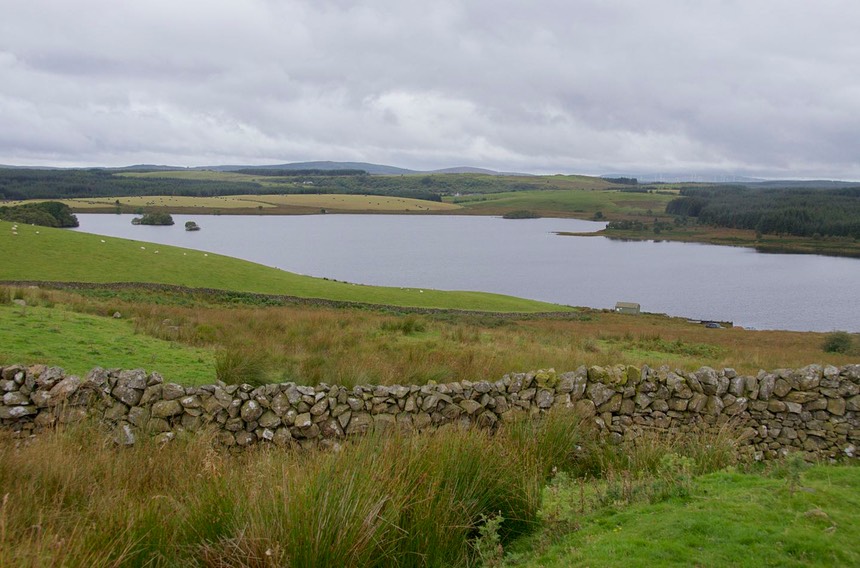
We then popped across the border and made a beeline up to Glasgow, where we spent a few days with our buddies there. Knowing my wishes, Susan had arranged for a viewing of some cool old medieval Pictish stones, as well as a visit to the Hunterian Museum and Art Gallery. I wanted to see the Charles Rennie Mackintosh exhibits — he’s a famous architect —but sadly that area was closed off for restoration. There was, however, a totally marvelous exhibit on the Antonine wall (similar to Hadrian’s Wall, but about 20 miles further north) that we thoroughly enjoyed. And… across the way, a very interesting display of new archaeological finds from a University of Glasgow dig underway. What a super time we had! With a lovely pub lunch followed by Friday night fish and chips to boot.
Waving so long, we then ventured out into the hinterlands of southwestern Scotland, where we devoted the next week to poking around. And the result? We found that southern Scotland is every bit as beautiful and interesting and rewarding as the areas further north that we love so much. So how about that! We’d passed through some of this area on past trips moving between England and Scotland, but found lots of wonderful corners to explore that we’d missed before.
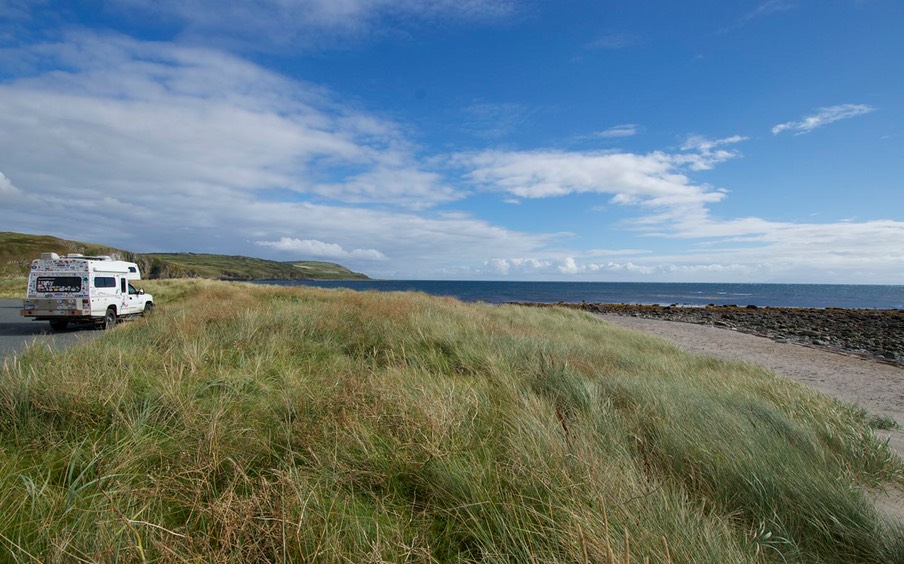
Meandering along, we spent one night parked next to a rugby club field positioned at the edge of little Kilbirnie Loch; naturally there were plenty of games to watch. We saw deer in the forests and pheasants (mostly dodging cars as they crossed the road) everywhere; and drove along forested lochs where we found plenty of places to cozy up for the night. In the Forest of Galloway we revisited the Robert the Bruce stone (magnificent) and trekked along the Reivers’ Road (reivers being old time bandits) which followed a pretty little stream.
We cruised along the coastline of The Machars peninsula, spending a night between the ocean and a local golf course — the signs all said “Watch Out for Stray Balls.”
We found the remains of St Ninian’s chapel south of Wigtown (Scotland’s self proclaimed national book town), and poked around the village as well. Most of the critters in the fields near here were dairy cattle, and it smelled like it. I found the Torhuse Stone Circle to commune with, joining a couple of local lasses who seemed to be preparing for the upcoming Autumn Equinox.
Large birds were in the air, we think the local Galloway kites. Magnificent. By surprise, we encountered the Sweetheart Abbey, south of Dumfries, and enjoyed a visit with this lovely ruin. Ah, and then we drove up a valley northeast of Moffat, following Moffat Water, and spent a night at the Grey Mare’s Tail falls, a nature reserve. The road through this valley is the A708, and it travels through one of the prettiest glaciated valleys we’ve seen yet. You must be sure to mark it down!
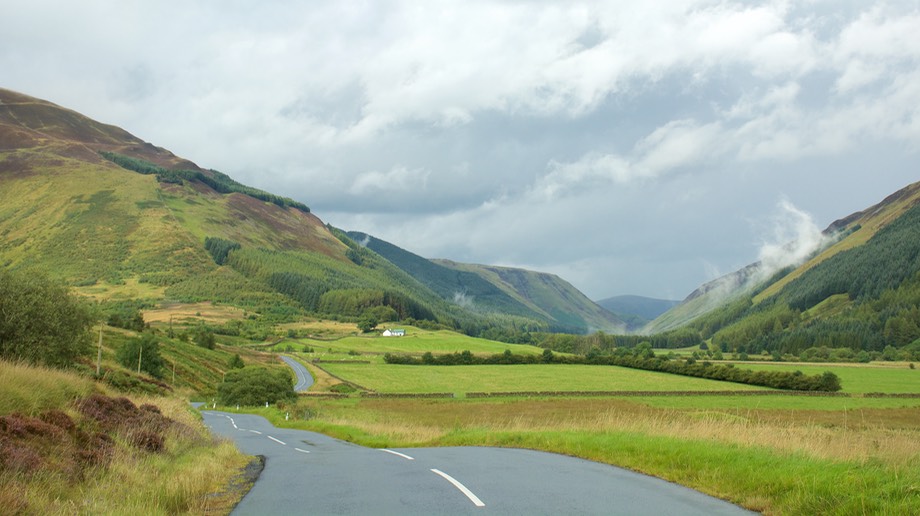
While traveling in Scotland over the years, we’ve learned that there is a legitimate reason why Scotland seems so much more rugged and rocky than England, and were reminded of it again on this visit. Geologically, Scotland comes from an entirely different tectonic plate than does England. England broke off from the European plate just as you might suppose, but Scotland broke off from Africa of all places, and over millions and millions of years drifted north and somehow managed to slam into England; what are the odds? With a past like that it seems it would take more than a mere election to separate the two.
Southern Scotland has moors all over the place, filled with blooming heather and gorse; they are nice to ramble through, park up next to, and bird watch at. We communed with the moors as we traveled along. Just before leaving Scotland, we revisited Scott’s View (Sir Walter) up above Melrose, and waved at the Wallace Monument nearby… and the Waterloo Monument further down the hill. Britain is big on monuments. After a quick stop at lovely Jedburgh Abbey, we followed Jed Water down to the English border, hopped across to the sound of the pipes being played at the Visitor’s Center, and found ourselves in England’s Northumberland National Park. We’d had a thoroughly enjoyable week in Scotland, and it was only mid-September. Lot’s of time left; pant, pant.
England in the autumn is just as pretty as Scotland; this is the time of year we like best in Britain. Trees are turning, the wheat’s been cut and we like the contrast of the color of the stubble; oh, and the quality of the light is soft and rich, perfect for taking pictures.
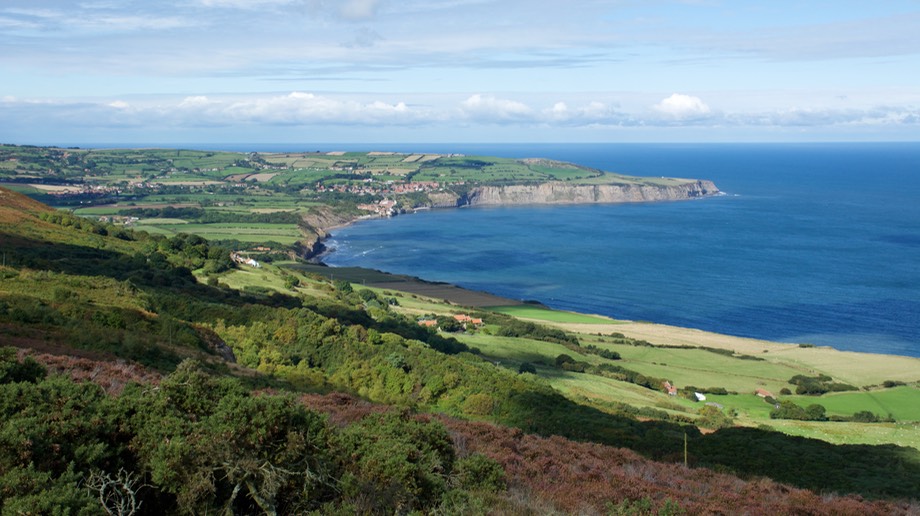
Moving a bit south and east, we gently headed toward Whitby, an old resort town on the coast. We spent a couple of nights in the North York Moors National Park (and no, I’m not clear on where it started and where the Northumberland NP left off — there’s a lot of green on this part of the map of England).
In the North York Moors we climbed up to the top of the Captain Cook Monument. We weren’t close enough to the coast to spot the sea, but James Cook had been born near here and it was a nifty monument. We then moved further east across the moor on an appropriately drizzly day through little villages with stone cottages and fields of sheep interspersed among the playing fields. The heather was in bloom, the fireweed all done for the year, and sheep all over the little farm road we were taking. (We’ve long known that we are happiest when there are sheep on the road, how about you?.)
Our road took us up steep hills (25% grade) and back down, under old, low bridges with train tracks overhead, and past old brick buildings and walls that had scarlet ivy clinging to their sides. There were lots of “ramblers” out wandering the hillsides, even in heavy rain.
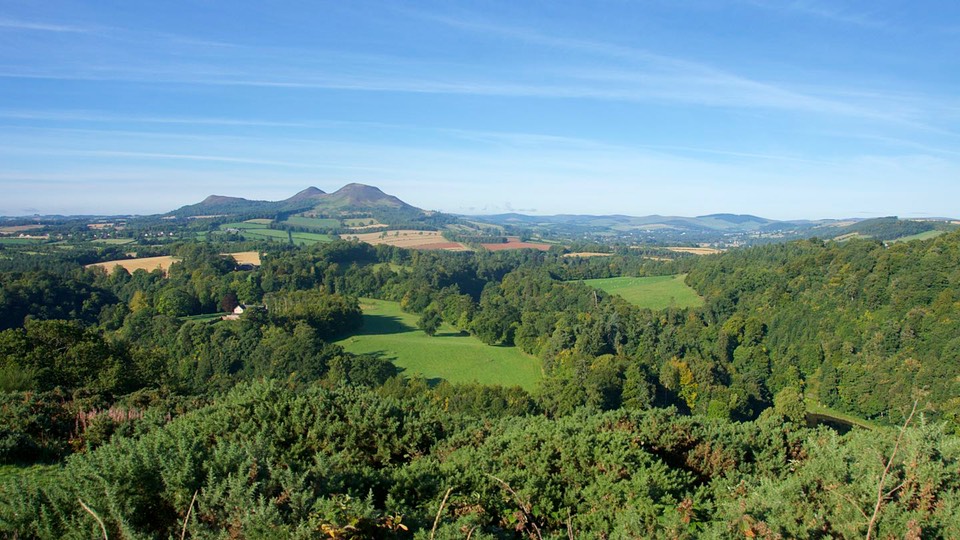
We stopped for a couple of days on the east side of the Howdale Moor, south of Whitby. We parked right next to the moor, which had a bunch of prehistoric stones just ripe for picture-taking, and I kept an eye out for Heathcliff (this wasn’t actually his stomping ground, but I couldn’t help myself). It was very atmospheric, particularly when a storm came up, complete with lashing rain and strong winds. Cool.
We had set out for Whitby, an old 18th century resort town, on purpose. We’d been told the town had the best fish and chips in England. It was also the setting of the historic parts of the movie “Possession” (we like those parts of the movie best, but the modern part of the story is ok too though Rick likes it better than Kathy). Whitby is picturesque and now, in September, rather quiet. The summer months are different. It has a lovely bay which we walked along, and a nice enough old section, along with a truly splendid abbey ruin. We never did get F&C here, as we’d gotten a better offer for a little later in the week, and didn’t want to over-do. But we were there on a pretty day, the seaside setting is charming, and we grooved.
Our “better offer” had come from some new friends, Les and Margaret, whom we had met at the Silk Route gathering. They had invited us to visit them at their home in Saltaire, a very interesting community a bit west of Leeds. It’s a purpose-built town, erected in the 1850s to support a woolen mill established there by a certain Mr. Salt, and it sits along the River Aire; hence the name. The workers were housed, fed, schooled, and cared for in the various structures in the village. As a model for Victorian architecture and urban planning, the entire village has UNESCO World Heritage status, and it makes an interesting wander. Our friends live within the community and are involved in its management. They shared a lot of the history of the community — and the fish and chips were indeed sublime.
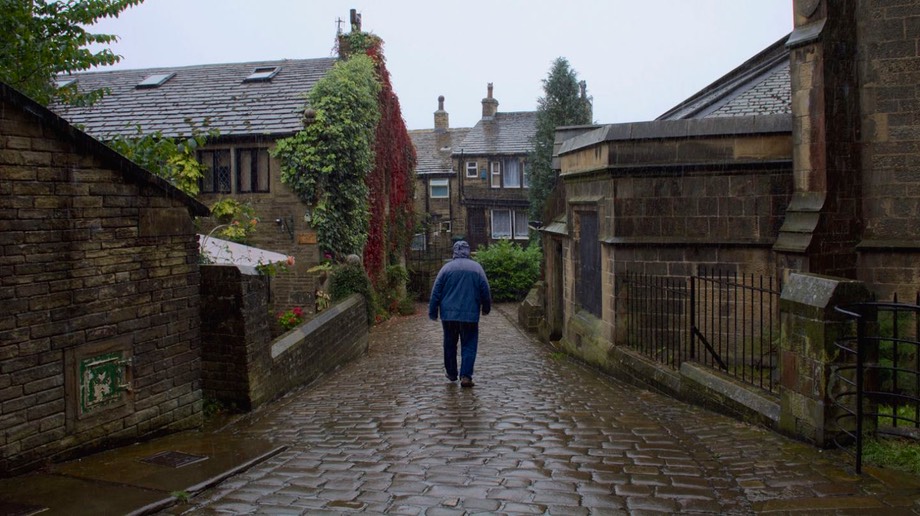
Just as cool was the offer of a personally guided adventure to Haworth, home of the Brontë sisters. The parsonage, where they lived, is a really good museum about them and their literary works. It sits right on the edge of the moors which featured in so much of their work, perhaps most famously Wuthering Heights. I walked outside the museum towards the fields beyond; it was misty and starting to rain. A perfect moment. I just knew the ghost of Heathcliff was nearby. In the museum shop I bought a copy of the book to enjoy on the plane home.
For lunch, we stopped in at the Villette Coffee House for Yorkshire pudding, tunamayo on a potato jacket, and other local delicacies, followed by curd tart and parkin for our pudding. It was a really nice day. Oh, and we found out that “wuthering” was exactly what the weather was doing that day — drizzling and being misty and windy. Perfect.
We hated to leave Yorkshire and our new friends, but time was passing, so we dropped down through Nottingham (almost lured off course by a sign showing the way to the Southwell Ploughing Match) to an open field at Stratford-upon-Avon, where we spent a nifty weekend enjoying the Adventure Overland Show. It was filled with overland vehicles, talks by those who’d been to far distant places, chances to meet up with old friends and make new ones, and get inspiration for our next adventures. We can hardly wait for the future to arrive!
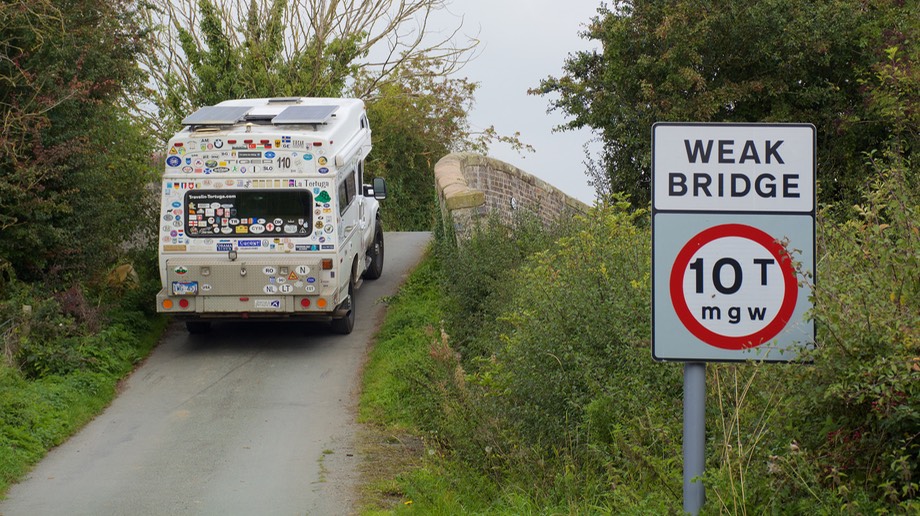
But in the short term, we were heading for Wales. We made a short stop in Coventry on our way there. We’d been to Coventry very briefly, back in 2010, and I was demanding a return trip. I wanted a chance to quietly experience the cathedral there, which had been bombed to smithereens in World War II, and then left as is as a reminder of the horrors of war. Well, yes, but only parts have been left in ruins; other aspects of it have been renewed and are now an integral part of the city. It was interesting to see, and somehow fitting that the cathedral is directly opposite the University of Coventry. As a result of that proximity, there are students wandering all over the building all the time; I liked that.
While I poked around in the ruins, Rick was taking a look at the nearby branch of the National Motor Museum. Coventry had a very large role in British manufacturing going right back to the industrial revolution and the museum tries to tell that story. Beginning with small manufacturing like sewing machines, then developing into bicycles then motorcycles and finally automobiles, Coventry was a busy place. It’s a nice museum and does a good job of sharing some of the history of transportation manufacturing in Coventry.
And then, after a last weepy good-by to Rick’s cousins in Codsall, on to Wales. We had been in Wales for about two weeks in 2010, and now we’ve spent another week. And the decision of the jury is in. Your Tiger-traveling friends announce loudly: Wales is almost as cool as Scotland! For such a small country, it sure does pack in a lot of pleasure. Over several lovely fall days (with very cold nights), we spent our time quietly wandering little “highways”, ducking gently around blind corners, going up and down steep grades, and trying to keep away from the stone walls on the single track roads. We talked about how these were possibly the tiniest roads we’d ever seen, every bit as narrow as those in southern England for sure. Happily there was a bit less in the way of other traffic.
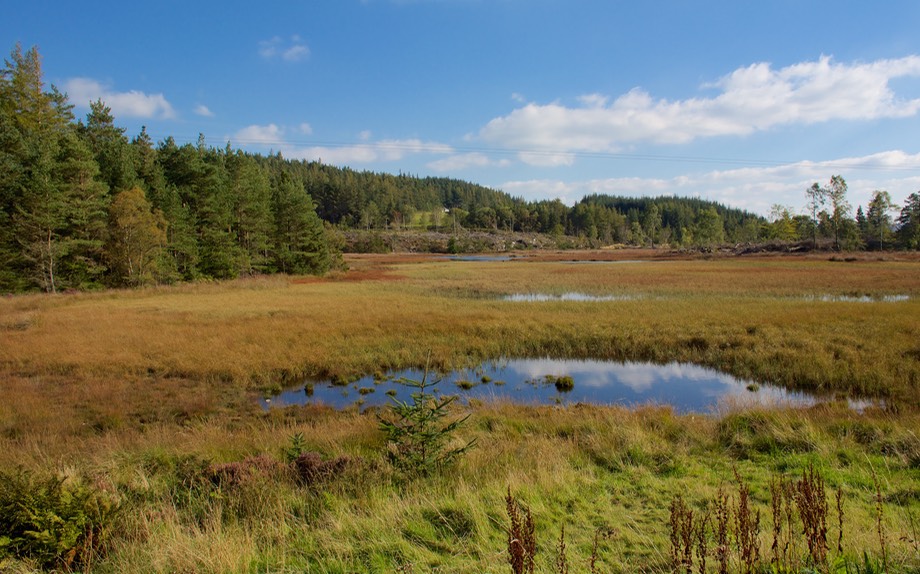
Wales is full of protected, remote areas, and we tried to see as many parts as we could. Snowdonia NP is quite magnificent. Somehow we’d both assumed it would be covered in, well, snow of course. Perhaps true in winter, but in the fall it’s barren, open land, covered with heather and other low plants. Great hiking areas.
The northwestern part of the country is the island of Anglesey; it’s much flatter out there, lowlands really, and contains a nice shoreline; a softer part of Wales than the rough, mountainous mining areas. Anglesey is “home” to lots of burial mounds that can be visited; many just sit near the roadway, which is pretty nice. We spent some time at one, Barclodiad y Gawres, the largest Neolithic tomb in Wales, and then went to an exhibit about it at the museum nearby, Oriel Ynys-Mon in Llangefni. And yes, of course, I’m just showing off all the strange words I know!
Anglesey is attached to the mainland by two bridges, a squeaky narrow one (the Menai Bridge) built in 1826, and the “new bridge” (the Brittania) built in 1850. The Brittania charges a toll so we of course stayed with the Menai Bridge both ways, each time tucking it all in and moving rather slowly with a combined six inches clearance on our side mirrors. It was a reminder that in 1826 it simply needed to be wide enough for a horse and cart. Later on, we saw some old photographs showing drovers moving herds of sheep across the Menai Bridge; the drovers were hired to take the herds (cattle as well as sheep) to market for sale, sometimes as far away as London. A very difficult life!
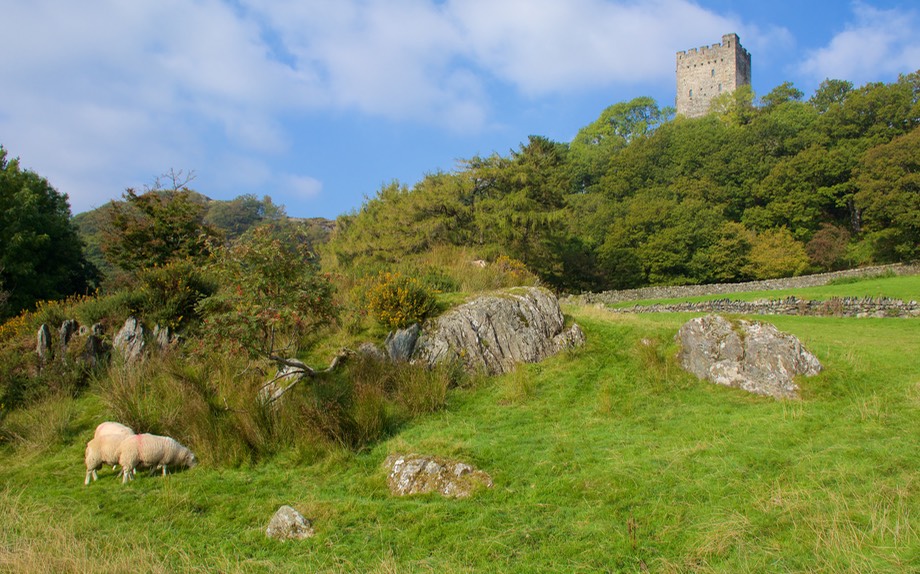
We started mosey-ing south and then east, spending a last couple of quiet days in Wales as we headed back towards England. We were not in a hurry to enmesh ourselves in the increased traffic and bustling nature of those folks across the border, but knew that our shipping date was fast approaching and we still had things to do.
We touched in at Aberystwyth on the coast, and then followed the train route east up the Vail of Rheidol to the Devil’s Bridge, which is actually a grouping of three bridges crossing a narrow gorge that were built over the past nine hundred years; each time the newer version was placed directly on top of the one that came before it and all three remain visible today. In a refreshingly old-fashioned manner, it was a fun place to visit. You paid your one pound, walked through a clunky old turnstile, and down some very steep, very slippery stairs to the viewpoint for the bridge. The viewpoint was situated just above the rushing waters of the river that had long ago formed the canyon that was the reason for the bridges in the first place. It was lots of fun, and the view from the bottom was quite amazing. We really enjoyed ourselves. And there was an ice cream stand right at the exit. What more could you want?
We went further east over an old drovers’ road; it crossed the Abergwesyn Pass between Tregaron and Abergwesyn. We’d been over this amazing pass before; it was just as lovely as the last time, and we found the same overlook we’d stayed the night at in 2010. The next morning, a Sunday, we were just able to get off this single car track in time to let what must have been a total of 20 small cars go by — Rick made up the name the Cotswold Hatchback Club for them — including a camera car bringing up the rear. They were having a terrific time whipping around the corners and speeding up the track.
Further east the land straightens out and becomes softer and gentler. We stopped in Builth Wells, an old spa town, and took a look around. There’s a nice river running through it with a pretty bridge (over the River Wye), some old buildings and lawns, and ducks in the water. You see why we like Wales?
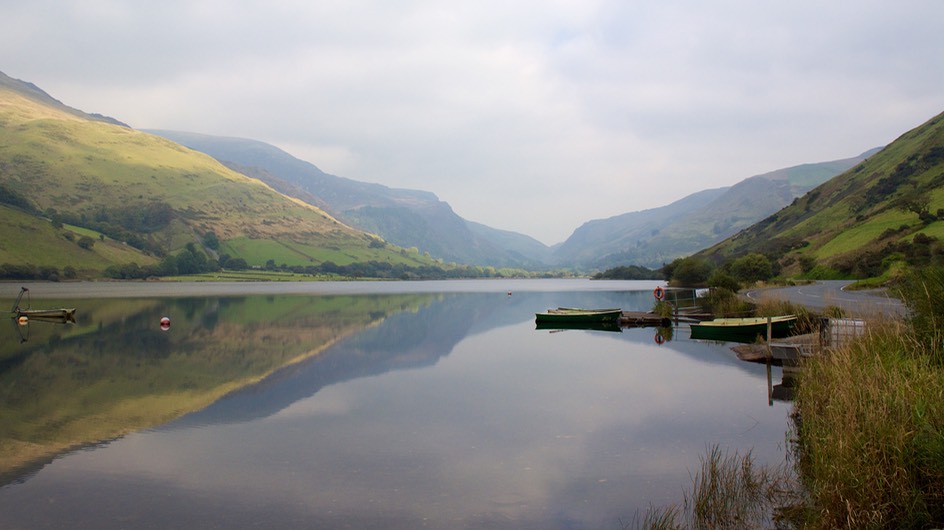
Too soon we crossed back into England and started to pick up our pace. We had a few days left before our flights home and still lots to do. Rick managed to fit in some motor museum visits, and we both worked a lot to tidy up and prepare to put the Tiger on a ship.
We’d not shipped the Tiger anywhere for several years. La Tortuga had been on a lot of ferries with us, but an actual shipping experience is much more formal. It combines getting all the food eaten up with trying to clean, organize what will come home with us, and toss out what is no longer wanted. Oh, and meet whatever requirements the shipping company had before letting the Tiger on board. It’s a bit of a job. But by now we were ready to start the process.
Rick had planned visits to two motor museums located near Southampton and managed to get to them during this last week. The best was the Sammy Miller Motorcycle Museum in New Milton, between Southampton and Bournemouth. Sammy is a championship rider in several types of motorcycle competition, though he is probably best known for his trials riding. He’s eighty-two now and still active. His museum is a real gem and should be considered a must visit for any enthusiast. Over three hundred bikes in lovely condition are arranged throughout a converted set of farm buildings. The setting is complete with chickens, geese and several alpacas in the corral. A lovely spot and a great collection.
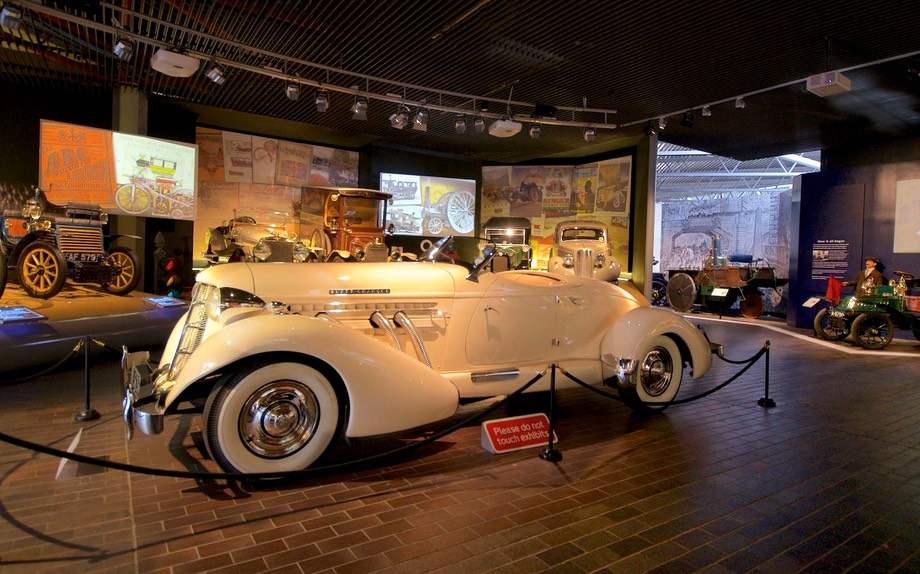
Also on the menu was the British National Automobile Museum at Beaulieu, pronounced Bewley in true Brit fashion. This is an excellent collection housed in a nice purpose-built building on the grounds of an historic estate. One great feature of our visit was the daily start up of one of the cars in the collection. Rick enjoyed learning more about the features of a 1914 Rolls Royce and then hearing and seeing the engine of this great old machine start up and idle as quietly and smoothly as you could imagine. The only real drawback to visiting the museum is its rather high cost, as admission also covers the grounds and buildings of the estate. As soon as he can get the photos prepared, these museums will be added to our motor-museums.com website together with those from Oulton Park and the Cosford Air Museum.
All of the above accomplished and put to rest, we spent our last night at a pub not too far from Southampton where we met up with new friends John and Rosemarie, whom we had also met at the Silk Route gathering. We all stayed the night in the pub parking lot, a very nice British tradition, had a terrific dinner and enjoyed a really great evening together. We share a lot of interests, and kept on gabbing until far into the night. After hugs good-by in the morning, we left to take care of last minute chores and then headed for the docks in Southampton.
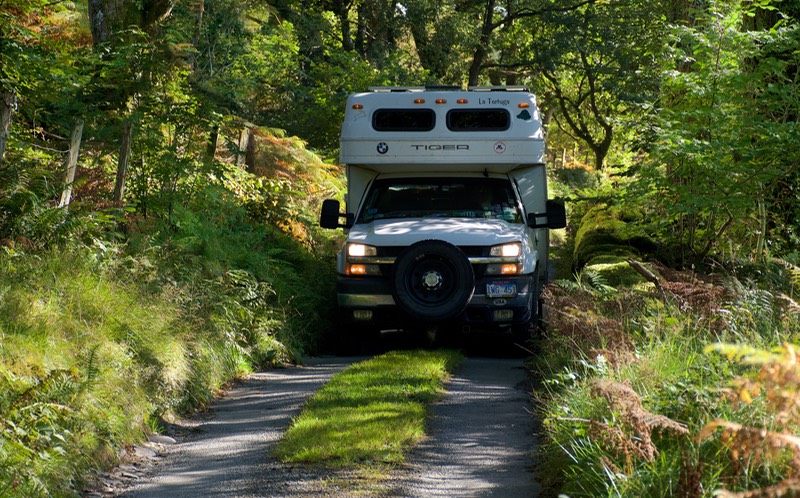
Parting with the Tiger was the usual hassle; port authorities aren’t much fun anywhere in the world, and England is more — might I say — righteous than some. But La Tortuga finally cleared all the hurdles, we waved so long, and started our long voyage home. We were sad to leave England, but we firmly believe we will return.
So on to new adventures! We will be in the States for at least a year. The Tiger has an appointment back at the factory for some fixes and changes as well as plans for other maintenance and upgrade work along the way and we are beginning research into where our next adventures will take us. We have many travel plans for while we are in the U.S., and many possible targets for our next flights overseas.
So stay with us!
Much love from Rick and Kathy, and La Tortuga gives a wave from aboard ship; Bon Voyage.